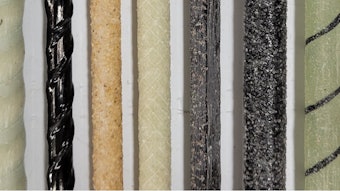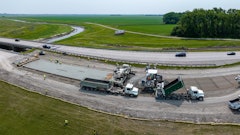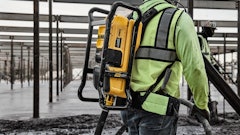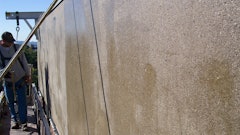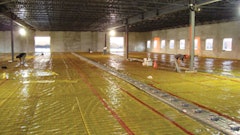
For concrete contractors, concrete saws are must-have tools for slicing through hard materials such as concrete, asphalt, tile, and brick. Choosing the optimal saw—and just as important, the optimal saw blade—for the cutting application saves time and makes it easier to deliver high-quality results that keep clients coming back for more.
The choice of saw and blade depends on a host of factors, including the material, the shape of the cut, the depth of the cut, and the project location. For example, contractors will want a different saw for making long, straight cuts on pavement vs. making precision square cuts for windows, and potentially, different saws for working indoors vs. outdoors.
Using the wrong saw or blade for the cutting task can take more time, yield poor results, and pose serious safety hazards. Injuries from saw kickbacks, blade fractures, and other incidents are not uncommon and can cause downtime that delays projects.
This guide outlines four common types of concrete saws, as well as power source and blade options, to help concrete contractors evaluate what cutting equipment to rent or purchase for maximum ease, efficiency, and safety.
Cutoff Concrete Saws
Handheld concrete saws, called cutoff concrete saws, cut concrete and asphalt, metal, and masonry materials. Compact and versatile, cutoff saws can handle a wide range of tasks, such as cutting through concrete walls, slabs, and floors, creating openings for plumbing and electrical installations, and demolishing concrete and infrastructure wreckage.
A small, handheld cutoff saw is ideal for quickly cutting and adjusting building components onsite. A concrete saw can also be mounted on a table and equipped with a diamond blade or carbide masonry blade to make shallow, clean, precise cuts in brick, block, or stone.
Concrete Chainsaws
As their name implies, concrete chainsaws use a chain with cutting teeth to slice sharp angles and square corners in concrete, blocks, brick, and stone without overcutting. A diamond-coated, water-cooled chain runs along the perimeter of the oblong blade.
Concrete chainsaws are small and handy for accessing hard-to-reach areas. They are ideal for breaking up and removing large concrete sections during demolition, creating joints, and cutting openings for windows, doorways, beam pockets, HVAC components, and electrical boxes.
Concrete Wall Saws
Concrete wall saws are designed to make precise vertical and horizontal cuts in walls or sloped surfaces made of concrete, stone, asphalt or cinder block. They are often used to cut apertures for doors, windows, plumbing, and electrical. Typically, these saws are fitted with a diamond blade and mounted on a track that supports them during operation.
Walk-behind Concrete Saws
Sometimes called floor saws or street saws, walk-behind concrete saws are large, heavy, wheeled saws that are pushed from behind. Some models are self-propelled, which makes it easier to move the saw forward and backward.
These heavy-duty saws cut long, straight lines and are ideal for work on asphalt roads, concrete floors, driveways, sidewalks and slabs.
 STIHL | United Rentals Inc.
STIHL | United Rentals Inc.
Power Source Options
Many concrete saws come in different power source options, including gas, corded electric, battery, pneumatic, and hydraulic models. Gas saws are the most powerful and often the fastest way to cut materials such as concrete, asphalt, and steel with fewer passes.
Electric saws are a more sustainable choice. They are less powerful, but they also weigh less, emit no fumes, and are easy to start. They perform well as general-purpose saws and on indoor tasks. These saws must be used near a power outlet and shouldn’t be used with wet-cutting techniques.
A battery-powered saw is a smart option for light-duty indoor or outdoor tasks and work in confined spaces. They offer maximum portability and produce zero emissions and less noise.
Pneumatic saws are useful for making fast, simple cuts, and like battery-powered saws, they are low maintenance. Hydraulic saws offer a lot of power for their weight, but they require a hydraulic power unit.
Matching the Blade to the Material & Saw
Deciding the type of saw blade to use on a project is as important as choosing the saw. Concrete contractors will likely need a variety of blades.
Different blades are designed to cut different materials at fast or slow speeds. Selecting the right blade for the material and matching the speed rating of the saw to the safe operating speed of the blade will make all the difference in the quality of the work and preserve the longevity of the saw and blade.
Blade choice affects the amount of dust generated. Saws designed for wet cutting feature a water attachment to reduce dust and cool the blade during operation. Minimizing dust provides a clearer field of vision and reduces the health risks associated with dust inhalation. (Of course, contractors should always wear appropriate PPE.) Wet cutting generates slurry, which must be contained or removed.
Diamond Blades
Diamond blades feature synthetic diamond particles embedded in a steel core. Known for their performance, durability, and temperature tolerance, diamond blades suited for concrete saws come in three main types:
- Segmented blades. These blades feature gaps between the diamond segments to provide faster cooling and debris removal. They make rough cuts in concrete, asphalt, brick, and limestone. They are dry-cutting blades, meaning they don’t need water to cool them during operation, though they can be used with wet cutting. Dry cutting requires repeated short cuts.
- Continuous-rim blades. The solid, continuous rim of these blades makes slow, clean, smooth, precise cuts on materials such as granite, porcelain, marble, and tile. They require a water stream to cool them during operation.
- Turbo-rim blades. The aggressive turbo-rim blade, which features a continuous, serrated rim, is ideal for making fast, smooth cuts in natural stone, concrete, brick, tile, and masonry. Blades of this type are available for dry and wet cuts.
Abrasive Blades
Abrasive blades, also known as abrasive cutoff wheels, are circular blades made of silicon carbide or aluminum oxide. They are often ideal for cutting softer materials such as asphalt, green concrete, and brick. They can also be used to cut metal.
Less expensive than diamond blades, abrasive blades do have downsides. They create a considerable amount of dust. They are also considerably less durable than diamond blades, so you’ll have to replace them often, and they can crack or shatter unless they are reinforced with fiberglass and a strong bonding agent.
Making Sense of the Options
Leveraging the most appropriate tools increases the odds that work goes smoothly and efficiently and therefore profitably. But choosing saws and blades, especially for contractors who perform complex projects involving a variety of tasks, can sometimes be challenging.
Renting equipment is a smart way to try it out. A vendor with a large selection of saws can help concrete contractors think through their needs and guide them to the best equipment for the job. With the right saw in hand or at hand, contractors can cut with more confidence.





